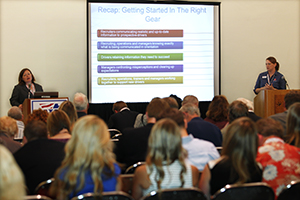Managing Editor
Experts Pinpoint Recruiting Challenges

SAN DIEGO — Stiffening competition for truck drivers and misperceptions about their work-lifestyle balance are among the biggest challenges to recruitment, according to industry experts.
But key to besting those challenges is the initial meeting where expectations as well as contentions can be resolved, the experts told American Trucking Associations’ Management Conference & Exhibition here on Oct. 6.
The comments were made during a workshop called Recruiting and Operations Alignment: Getting the Driver Relationship in the Right Gear.
The shortage of truck drivers is a concern for the industry in general, but the problem is currently magnified because of record tonnage available for movement.
Strategic Programs Inc. consultant Megan Younkin and Holly McCormick, a recruitment and retention manager with tank-truck carrier Groendyke Transport Inc., said that according to driver feedback about job expectations, a minority of new drivers — 45% — reported the reality of the job matched their expectations, while 56% said recruiters truthfully described what to expect.
To bridge the gap between expectations and reality, employers should ensure current information about the company is available, especially on the company’s website, because 79% of prospective drivers look for jobs online.
Drivers and managers should participate in the orientation to ensure a consistent message, which makes managing drivers easier, the experts said.
McCormick said that someone from her company’s operations division participates in driver orientation to emphasize the role they play in retention. For a driver, just knowing of organizational support is very important, she said.
“A sense of belonging is more important than ever to our industry,” McCormick said.
Just as important is confronting misperceptions and clearing up expectations so that the driver gets what is needed to be satisfied and the company gets what it needs from the driver to be successful, they said.
“There should be an expectations exchange — a conversation between driver and manager — about things like mileage, home time, pay structure, company contacts,” said Younkin, adding that they signal to a driver that the company wants to see them be successful.
Social media has proven forceful, too, in retaining drivers because when drivers can get to know each other through comments online it helps develop a sense of belonging, the experts said.
August’s truck tonnage index jumped 4.5% from a year ago to a record 132.6 reading, ATA reported on Sept. 23.
Bob Costello, the federation’s chief economist, said the shortage was “as bad as ever and is expected to get worse in the near term” as freight volumes continue to grow.
He reported that turnover — often a proxy for tracking the driver shortage — rose 11 percentage points to an annualized rate of 103% in the second quarter.
The increase set the rate at its highest point since the third quarter of 2012.
Turnover at small truckload fleets (less than $30 million in revenue) surged 16 points to 94%, the highest level since the third quarter of 2012.
“These turnover rates show that the shortage is acute,” Costello said, “and if the freight economy continues to grow, it will worsen very quickly.”

